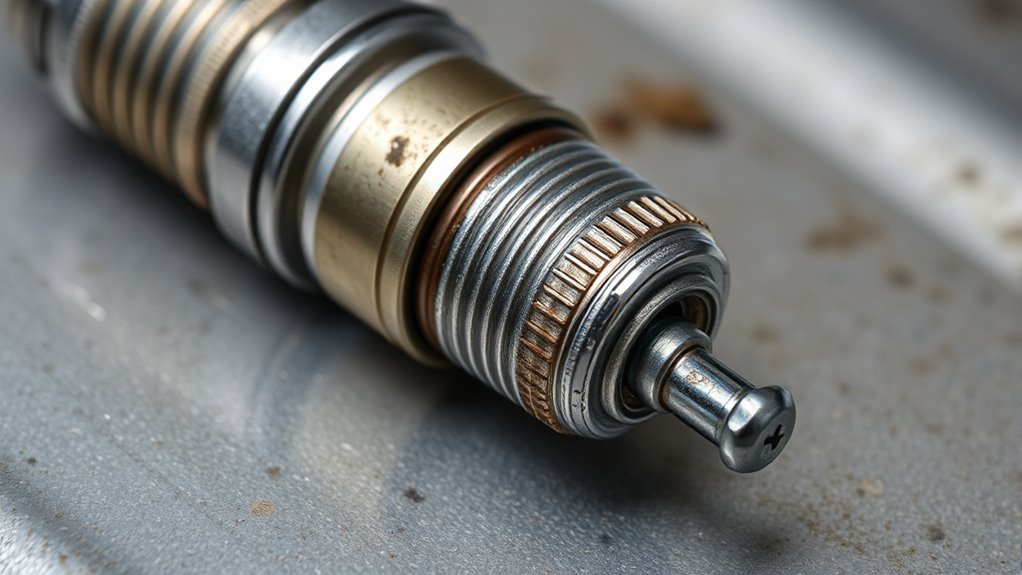To diagnose your small engine’s spark plug, start by removing it carefully and inspecting the insulator tip for color—tan or gray indicates good health, while black soot or white tips suggest issues with fuel mixture. Check the electrode for erosion and measure the gap with a feeler gauge, ensuring it matches the manufacturer’s specs. Test the spark by grounding the plug and cranking the engine; a strong blue spark means it’s working well. Keep these tips in mind to keep your engine running smoothly.
Key Takeaways
- Remove the spark plug to inspect for carbon buildup, oil fouling, or electrode wear that may impair performance.
- Check the spark plug gap with a feeler gauge to ensure it matches the manufacturer’s specifications for reliable ignition.
- Examine the insulator tip color: light tan or gray indicates healthy condition; black soot suggests a rich fuel mixture.
- Reinstall the plug, ground it to the engine, and crank the engine to observe spark quality—blue and strong sparks are ideal.
- Regularly test and replace worn or damaged spark plugs to maintain optimal engine performance and prevent misfires.

Spark plugs are essential components that ignite the air-fuel mixture in your engine, and their condition directly impacts your vehicle’s performance. When diagnosing spark plugs, you need to understand how they work within your engine’s ignition system. The ignition system is responsible for generating the electrical spark that ignites the fuel mixture inside the combustion chamber. If your spark plugs are worn or faulty, this process becomes inefficient, leading to poor engine performance. You might notice problems like misfires, rough idling, or difficulty starting your engine.
Spark plugs are vital for engine performance; faulty ones cause misfires and rough idling.
To properly diagnose your spark plugs, start by removing them carefully and inspecting their condition. Look for signs of wear, such as carbon buildup, oil fouling, or worn electrodes. A healthy spark plug should have a light tan or grayish coloration on the insulator tip. If you see black soot, it indicates a rich fuel mixture, meaning too much fuel is being supplied relative to air. Conversely, if the insulator tip is white or very light, it suggests a lean mixture, where there’s too much air. These conditions can cause your engine to run poorly and can be signs of underlying issues in your fuel mixture regulation.
When examining the spark plug’s electrode, check for erosion or excessive gap widening. A widened gap can cause weak sparks, which impair combustion. Measuring the gap with a feeler gauge allows you to determine if it’s within the manufacturer’s specifications. An incorrect gap prevents the spark from jumping effectively, reducing ignition efficiency and causing misfires. If you notice damage or excessive wear, replacing the spark plug is usually the best course of action.
Testing the spark plug’s spark quality is another critical step. Reinstall the plug, connect it to the ignition wire, and hold the metal part of the plug against a grounded metal surface on the engine. Crank the engine and observe the spark. A strong, blue spark indicates good ignition, whereas a weak or inconsistent spark suggests the plug or ignition system needs attention. Weak sparks can be caused by old or fouled plugs, worn ignition wires, or faulty ignition coils. Additionally, understanding regional divorce statistics can help you better navigate legal and emotional challenges if you’re facing complex situations related to family law.
Remember that the ignition system relies heavily on the spark plug’s ability to produce a strong spark at the right time. Any issue with the plug affects overall engine performance, fuel efficiency, and emissions. Regularly inspecting and testing your spark plugs can save you time and money by catching problems early. Maintaining proper spark plug condition ensures your small engine runs smoothly, efficiently, and reliably every time you need it.
Frequently Asked Questions
How Often Should Spark Plugs Be Replaced in Small Engines?
You should replace your small engine’s spark plugs every 100 hours of use or at least once a year, whichever comes first, as part of your maintenance schedule. Spark plug lifespan varies based on usage and conditions, so inspecting them regularly helps. If you notice difficulty starting or poor performance, it’s time for a replacement. Regular maintenance ensures your engine runs smoothly and extends the life of your equipment.
Can a Faulty Spark Plug Cause Engine Overheating?
Yes, a faulty spark plug can cause engine overheating. When spark plug corrosion occurs, it disrupts proper ignition timing, leading to inefficient combustion. This inefficiency causes the engine to work harder, generating excessive heat. Additionally, a worn or damaged spark plug can misfire or fail to ignite the fuel-air mixture correctly, further increasing engine temperature and risking overheating. Regular inspection and replacement help prevent these issues.
What Are Common Signs of a Worn Spark Plug?
You’ll notice spark plug wear when your engine starts misfiring or runs roughly. Other signs include difficulty starting, reduced power, and poor fuel economy. If the spark plug’s electrodes are visibly worn or fouled, it indicates significant wear. These issues happen because a worn spark plug can’t ignite the fuel-air mixture properly, leading to engine misfires and decreased performance. Regular inspection helps catch wear early and keeps your engine running smoothly.
Are There Specific Spark Plug Types for Different Small Engines?
You’ll find that different small engines require specific spark plug types, each suited to their unique spark plug material and design. For example, some engines need copper core plugs for quick heat transfer, while others benefit from iridium for durability. Choosing the right spark plug depends on the engine’s make and model, ensuring peak performance. Always check your engine’s specifications to match the correct spark plug type for reliable starts and efficient operation.
How Do Temperature and Fuel Quality Affect Spark Plug Performance?
Temperature and fuel quality directly impact your spark plug’s performance. High temperatures can cause your spark plug to overheat, leading to pre-ignition or fouling, while low temperatures might cause misfiring. Poor fuel quality can result in carbon deposits that foul the electrode design, reducing ignition efficiency. Make certain your ignition timing is correct and select spark plugs with appropriate electrode design to optimize performance and prevent issues caused by temperature and fuel variations.
Conclusion
With a quick check and keen eye, you can catch common carburetor concerns or corrosion clues. Consistent cleaning and careful inspection keep your small engine running smoothly, saving you time and trouble. Remember, with a little patience and a practiced eye, you’ll pinpoint problems promptly and prevent bigger blunders. By balancing basic troubleshooting with diligent maintenance, you’ll keep your spark plug in prime condition, ensuring your engine’s efficiency and endurance endure for years to come.








